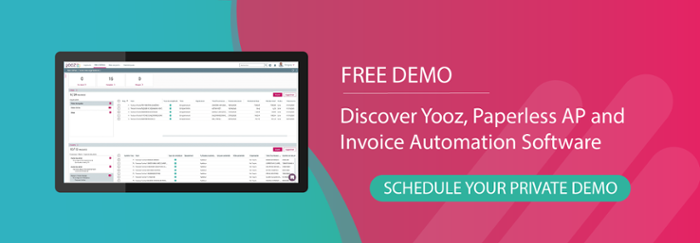Automation technology is one of the inevitable technical trends for companies who want to truly improve accounts payable efficiency in their organizations, especially in a complex and competitive economic environment. Once inaccessible to any but the largest corporations with significant cash flows, a move to cloud-based software has created an attainable solution with many benefits including cost reduction, process optimization, data security, regulatory compliance, and improved staff morale (to name a few).
However, not only do the benefits of automation technology affect the company's success, there is another oft overlooked benefit: accounting automation technology is also the heartbeat for measuring Key Performance Indicators (KPIs).
How Do You Know What Your Accounts Payable Key Performance Metrics Are?
According to Institute of Finance and Management (IOFM)’s Jess Scheer, at each stage of your Accounts Payable journey comes new challenges. At each level of development, the baseline for what makes for “good” Accounts Payable key performance metrics changes. As you streamline your roles and invest in new technology, you should become more efficient and effective. But once you automate your invoice payment process how do you know if you’re increasing efficiency? How do you know how much money you are saving the business? And how do you know if you have more productive employees doing strategic, value-added work?
Improving your Accounts Payable performance starts with determining operational benchmarks, establishing a baseline, and continually measuring your progress. As important as this assessment step is, few leaders do it today at all let alone on a day-to-day basis. Why? Our guess is that it may be because they've never done it and it seems too daunting not knowing where to start.
The IOFM report by editor Jess Scheer asks “Is Your Accounts Payable Performance Top Tier?” and offers guidelines for key metrics that you can use to chart your invoice processing and Accounts Payable improvement journey.
Collecting the Information Accounts Payable Departments Need to Track Performance
The first thing to do in order to start your journey is determine a baseline against which to create performance benchmarks. A few questions to do this include determining:
- Is your business centralized or decentralized?
- What level of Accounts Payable automation is your company currently running at?
- Are you already capturing early payment discounts from your vendors and suppliers?
- How much time does it take to process a single invoice?
- How much does it cost your company to process a single invoice?
Now let’s explore each of these questions further and measure how well your business rates.
Is Your Organization Centralized or Decentralized?
The first metric to identify is the organizational structure and automation enablement that most closely resembles where you are today. For example, you’ll determine if your organization is decentralized, partially centralized, centralized but with a shared provider, or shared services. This is how the IOFM report defines these categories for Accounts Payable department operations:
- Decentralized: operations distributed throughout businesses; no single Accounts Payable department.
- Partially Centralized: some Accounts Payable functions operate together, but many are scattered across the business.
- Centralized but Not a Shared Service: all Accounts Payable functions work in a single group, but Accounts Payable is not operating jointly with other related functions, such as procurement.
- Shared Services: all Accounts Payable functions are combined and working in tandem with all other related operational functions including procurement.

Identify Your Level of Automation
The idea is that the more invoices that are received electronically, the more automation can be enabled. Your business use will determine which category your company falls into: limited automation, moderate automation, or significant automation. Here are how the different levels of Accounts Payable automation are defined based on the percentage of invoices received electronically:
- Limited: 20% or less
- Moderate: 21% - 69%
- Significant Automation: 70% or higher
Capture Early Payment Discounts
In addition to saving money by reducing the time spent processing invoices and eliminating any late charges, one easy way to know if your Accounts Payable function is operating at a high level is whether you are capturing any early payment discounts that your vendor or supplier may offer.
The IOFM report tells businesses to evaluate savings with these categories:
- Potential: number of invoices that offer an early pay discount.
- Opportunity: typical percent discount offered.
- Results: share of discounts captured.
Now ask yourself these key questions to evaluate and improve your invoice and payment process using the three categories:
- How big is the potential for savings when you reduce the time it takes to process invoices and reduce or eliminate lost invoices?
- Accounts Payable automation software significantly increases the potential for savings. Without the right automation software, no matter how hard they try, companies will find that the maximum guaranteed savings will hardly ever exceed 5%. For example, having limited automation for just the invoice and payment process alone increases the organizations to secure at least 10% of potential early payment discounts.
- How big is the opportunity for savings per invoice?
- The average early pay discount is 2% per invoice. Depending on how many invoices you pay per month or year, this can be significant. For a larger company processing thousands of invoices every week (let alone month), obtaining early pay discounts can rapidly become a new income stream.
- How often are you able to capture discounts?
- “Top Tier” performers are capturing early pay discounts 85% of the time. Low performing Accounts Payable departments are only capturing these discounts one-third of the time. Based on the results from the IOFM report, there's a strong correlation between the low performing Accounts Payable departments being the least centralized and having little to no automation in their Accounts Payable process. The top performers tend to have significant automation and centralized to centralized with shared service to get their invoice processing done.
- “Top Tier” performers are capturing early pay discounts 85% of the time. Low performing Accounts Payable departments are only capturing these discounts one-third of the time. Based on the results from the IOFM report, there's a strong correlation between the low performing Accounts Payable departments being the least centralized and having little to no automation in their Accounts Payable process. The top performers tend to have significant automation and centralized to centralized with shared service to get their invoice processing done.

Determine How Efficient Your Accounts Payable Process Is
Your company's invoice and payment process automation software plays a significant role for invoice processing. It should increase speed for processing a high volume of invoices at a time. This way, you'll be able to lock-in early pay discounts, strengthen your performance metrics, cut costs, and increase efficiency because you're able to shorten cycle time to make the process more efficient.
1. How much time does it take to process an invoice?
One way to measure invoice processing time is by Number of Invoices/FTE. The equation will give you an overview of the total number of invoices divided by the number of full-time employees. This will help you determine whether you are under- or over-staffed and how you can streamline your team to do more value-added work while your newly automated Accounts Payable workflow takes over the mundane tasks. And remember, "the more decentralized you are, the harder it is to process invoices quickly".
2. How much does it cost to process an invoice?
It can go without saying that the longer it takes each of your Accounts Payable team to process an invoice, the more it will cost. On average, it costs almost $9 per invoice with either a manual or low level of automation. The cost is reduced to an average of $1.77 with a fully automated invoice and payment processing system. Depending on how many invoices your firm processes per month, the savings can be staggering! One of our Yooz clients, Patsy Price, Director of Operations, Peterson Auto Group, reported a savings of $35,000 per year with our Yooz Accounts Payable automation solution.
Check If Your Metric Tracking Is Top Tier by Its Effectiveness
Invoice process effectiveness means that the purchase order matches the invoice. How often do you have a mismatch? When a business relies on a manual invoice process, they put themselves at a high risk for errors from data entry or misplacing an invoice. These factors can make it hard to get an accurate measurement of cash flow and KPI metrics.
How many of your invoices have errors that require correction, and how much of each Accounts Payable employee's time is spent correcting errors? Here’s a hint: If your Accounts Payable performance is considered “Top Tier”, your employees should spend less than 1% of their time correcting errors. That will help your business reduce costs per invoice and increase cash from the difference you save.
These are also among the first few things you will identify when you are preparing to investigate the most appropriate invoice and payment process automation provider for your business. For a comprehensive checklist of how to prepare for your Accounts Payable automation journey, questions to ask potential providers, and questions those providers should ask you, download our satirical whitepaper, How to Mess Up Your Accounts Payable Project.
FAQs
What are the key performance metrics that organizations should track to measure the efficiency of their accounts payable processes?
How does Yooz's accounts payable solution help organizations track and improve key performance metrics such as invoice processing time and accuracy rate?
Can Yooz's accounts payable solution help organizations capture early payment discounts more effectively and improve their cash flow?
How does Yooz's accounts payable solution help organizations reduce invoice processing costs and improve cost-effectiveness?





